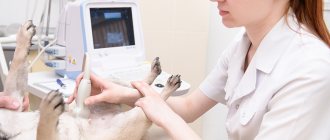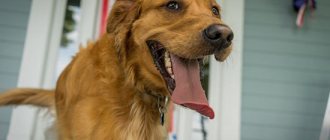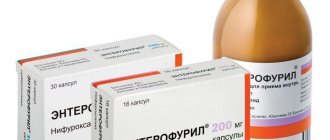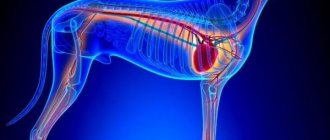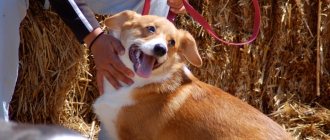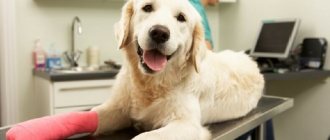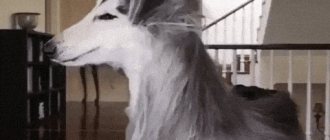Often, while stroking the dog, the owner discovers a lump on its body and immediately begins to panic, suspecting that the pet has a dangerous disease. Of course, fears may not be groundless.
It is likely that the lump under the skin has a cancerous etiology, but you should not sound the alarm without showing the animal to the veterinarian, because neoplasms may be harmless and may not even require treatment.
Causes of the disease
Lumps under the skin in different parts of the body can have different origins - a bee sting, a malignant or benign neoplasm, an abscess, etc. Some swellings go away after a couple of days, others increase in size over time and begin to cause serious discomfort to the pet.
The main reasons for the appearance of bumps on a dog’s body are:
- injury;
- viral infection;
- damage to blood vessels after surgery;
- oncology;
- penetration of bacteria.
If the subcutaneous lump does not go away after two days and bothers the animal, contact a veterinary clinic.
How to choose a clinic?
In order for your pet to receive effective care in the least amount of time, it is better to choose medical institutions with specialized specialists. It is better that the clinic is equipped with equipment: ultrasound, x-ray.
If surgical treatment is required, the presence of a hospital will be a definite advantage. This is necessary for high-quality preparation of the animal for anesthesia and subsequent recovery from it.
Attention! With bumps on your head, if you don’t know exactly the cause, it’s better to first contact a therapist; if necessary, he will refer you to a dermatologist, surgeon or oncologist.
Moscow clinics
- GrandVet. M. Babushkinskaya, Fedoskinskaya street, 13a, 2nd floor. Small but cozy clinic. There is a call service.
- Northern lights. M. Sokolniki, Bolshaya Ostroumovskaya street, 12. The clinic is distinguished by its highly professional staff and well-coordinated work.
- Ace Venturura. M. Troparevo, Academician Vinogradova Street, 1k1, 1st floor. A wide range of veterinary services, grooming is also provided.
Clinics of St. Petersburg
- Dr. Pets. Kollontai street, 30, building 1. m. Bolshevikov Avenue. The clinic specializes in reproductive medicine of cats and dogs. Interclinical conferences are also held. Takes part in charity events for the adoption of homeless animals.
- Network of veterinary clinics Kotonai. A large number of highly qualified specialists are constantly improving their skills and undergoing internships abroad.
- Vega veterinary clinic network. There is a branch in Moscow. The network has developed well-coordinated work between doctors and administrators, and there is a unified database of patients from all clinics. There is also a call service.
Clinics of Murmansk
- Kotonai. Dekabristov Street, 11. Branch of the St. Petersburg network of clinics. It is famous for the high professionalism of its doctors. Works around the clock.
- Zoolandia. St. Somova, 11. There is a veterinary pharmacy with a wide selection of drugs and feed.
Clinics in Krasnodar
- Bereginya. Krasnykh Partizan Street, 111. Patient owners note the clinic’s reasonable prices and polite staff.
- To Babushkina. Babushkina Street, 160. Wide range of veterinary services. The clinic staff prepares animals for exhibitions.
- Big Dipper. St. Mayakovskogo, 150. The clinic has developed veterinary dermatology, cardiology, orthopedics, ophthalmology, dentistry, therapy, and surgery.
Main symptoms
There is no single clinical picture for bumps on a dog’s body, since they can be caused by different diseases, each of which has its own characteristic signs.
So, with an abscess that occurs under the influence of a bacterial infection that enters the body through a bite, puncture wound or scratch, the dog experiences swelling, fever, and pain. The lump swells for several days, after which it begins to fester.
Smooth-haired dogs often develop papillomas and warts on their bodies. The cause of their occurrence is considered to be a viral infection. The growths on the skin are usually brown in color and are painless, but it is still worth consulting a veterinarian.
The dog may develop a hematoma as a result of bruises or fluid accumulation when blood vessels are damaged during surgery. It is a formation that changes the shape of the part of the body where it is located. It does not cause discomfort to the dog, however, if the hematoma does not go away for a long time, consultation with a specialist will also be required.
A cyst can appear anywhere: both on the body and on the dog’s face, for example, at the junction of the jaws. Upon inspection, it is quite easy to detect. It appears as reddish, painful abscesses that the dog tries to lick.
Pyoderma is a purulent inflammation of the skin in dogs, which is accompanied by a rash and papules. Swellings can form all over the body, paws, in folds of skin, and on the face.
Insect bites (bees, ticks and even mosquitoes) can cause painful swelling. The most dangerous bites are to the face and mouth.
There are two types of tumors in dogs: benign and malignant. Benign tumors grow slowly and, as a rule, do not cause discomfort to the dog. Unlike malignant tumors, they do not metastasize. However, this does not mean that they do not pose a danger to the health of the animal, since over time they can degenerate into cancer.
Malignant tumors appear as a result of cell mutation. Cancerous tumors are characterized by rapid growth, absence of symptoms at the initial stage, and metastases. Sometimes the bumps break through the skin and bleed. As the disease progresses, an increase in symptoms is observed.
Preventing the formation of growths
To reduce the risk of growths, it is recommended to adhere to the following rules:
- promptly treat skin damage;
give medications against ticks, worms, and other parasites;- bathe the animal at least once a week;
- treat infections promptly;
- if your pet shows anxiety, stops eating, sleeps a lot, immediately contact a veterinarian;
- nutrition should include vitamins and minerals to support normal organs, tissues, and strengthen the immune system.
Caring for a dog must be competent. If the owner does not know how to carry it out, consultation with a specialist is necessary.
Diagnostics in a veterinary clinic
To make a correct diagnosis of a dog, a veterinarian will need to examine the animal and do a number of necessary diagnostic tests, including:
- general and biochemical blood tests;
- Analysis of urine;
- Ultrasound;
- biopsy for histological examination of tissue;
- fingerprint smear - to determine cell atypia or the presence of an infectious agent;
- computed tomography - if a malignant tumor is suspected;
- radiography - to determine the depth of penetration of the lump into the soft tissue.
According to indications, additional diagnostic methods can be used to obtain more complete information.
What to do if you discover a problem?
If you find a lump on an animal’s head, then first of all you need to carefully examine and feel it. If the formation is painful for the animal, it is recommended to urgently show it to a doctor.
If the lump causes serious concern to the animal or other formations begin to appear over time, the veterinarian must first figure out what the cause of its occurrence is. In this case, one cannot do without an extensive list of studies, among which it is necessary to highlight:
- Radiography;
- Biopsy;
- Computed tomography;
- Taking a swab-imprint.
If the lump does not cause pain to the animal, does not secrete pus or change its color, the dog owner should observe the lump for many days. It is likely that such swelling will go away on its own. At the same time, you need to remember that you need to prohibit the animal from licking the area in the area of inflammation, as this may cause the occurrence of granuloma. If the formation begins to change, it is necessary to urgently show the dog to a doctor.
Treatment method and prognosis
After making a diagnosis, the doctor develops a treatment regimen. For each individual case, it will be individual depending on the disease, the severity of the animal’s condition, age, and tolerance (intolerance) to medications.
For cancerous tumors, drug treatment is not effective, since no drug can stop the development of the tumor. Radiation therapy, chemotherapy, and surgery to remove the tumor are indicated. After surgery, the course of chemoradiotherapy is repeated.
Benign tumors are removed surgically.
Treatment of abscess is also surgical. The inflamed area is opened, the open wound is washed, and Levomekol ointment is injected through the installed drainages.
The prognosis depends on the diagnosis. In most cases it is favorable, with the exception of malignant tumors. Cancer responds well to treatment if you contact a specialist in the initial stages of the disease. So, at stages 0, I, cancer is curable by 90%, at stages III, IV - by 50%.
Cancerous lumps
This is visually unnoticeable. Found during examination, combing, bathing. Seals are removed surgically. The pet requires treatment.
A tumor develops by using the body's resources. Cells change structure. The tissue begins to multiply and grow. The tissue looks like ulcers or bumps.
Some breeds are at risk of cancer. These are boxers, mastiffs, terriers, and retrievers. The patient loses his appetite and moves little. The affected area smells unpleasant.
Also, the affected area sometimes bleeds. At the same time, the pet begins to move differently. The swallowing reflex is difficult. Doctors' intervention is required.
Complications after injections
1. An abscess in a dog after an injection forms if pyogenic bacteria penetrate into the tissue (non-sterile preparation, use of one needle for several injections, etc.). The resulting cavity is filled with pus; the outside of the cavity is surrounded by the walls of the capsule, which is formed to protect the body from the spread of bacteria. It is strictly forbidden to open or puncture an abscess on your own.
Externally, an abscess looks like a swelling or lump, often painful and hot to the touch. For treatment, pain-relieving injections for dogs, compresses (not hot!), and ointments that draw out pus are prescribed. Sometimes the lump opens on its own, the contents pour out, and an ulcer forms on the sore spot. But more often they resort to surgical cleaning of the cavity (cut, remove pus, treat with an antiseptic). You cannot treat an abscess on your own! In advanced cases, necrosis, blood poisoning, and other complications that are no less life-threatening for the pet are possible.
Have you read it? Why does a dog shed in the fall and what to do about it?
2. But more often, if a dog has a lump from an injection, it is not an abscess, but an infiltrate. The reason is inflammatory, cystic and edematous tissue changes without the participation of pyogenic bacteria, that is, there is no cavity filled with pus. An infiltrate can form if the injection is made with a blunt, bendable or broken needle, if the needle is bent or broken during the injection, if the dog jerks sharply, if the drug is injected into a tense muscle.
In most cases, the temperature of the swelling is the same as the temperature of the tissues surrounding it. But externally it is impossible to distinguish an abscess from an infiltrate - the same lump from an injection, but the dog’s paw hurts less. If the lump hurts a lot and is hot to the touch, the infiltrate probably turns into an abscess, which is a complication (but an abscess cannot turn into an infiltrate). Infiltrates are treated with anti-inflammatory ointments and compresses, only after consultation with a veterinarian.
3. If you choose the wrong place to inject your dog, you can damage a large vein. Blood pours out of the vessels, resulting in the formation of a dense ball - a hematoma. Another cause of hematoma (as well as infiltration) is frequent injections into the same place. If the tumor after an injection in a dog is located close to the skin, a noticeable change in the color of the damaged tissue is reddish and then bluish.
4. If the dog limps after the injection, but there is no lump or redness in the injection area, the needle has probably damaged a nerve. Nerve damage is possible as a result of the formation of a drug “depot” if the drug is concentrated in one area and does not disperse to adjacent tissues. In addition, the vessel supplying the nerve may be blocked.
5. But the most dangerous complications after injections are not lumps and hematomas. The same injection of no-shpa to a dog can provoke collapse (a sharp drop in pressure). If air gets into the vein, a pulmonary embolism (cough, choking, bluish mucous membranes of the oral cavity) is possible. An acute reaction to the drug can lead to anaphylactic shock (severe weakness, drop in blood pressure, heart failure). All of these conditions are life-threatening and require immediate professional intervention!
Have you read it? Thai Ridgeback is the rarest, special and incredibly expensive
To minimize risks, follow three main rules:
- The doctor makes the first injection, and you carefully observe and remember the manipulation technique; follow all, even seemingly unnecessary, safety rules; at the slightest suspicion of a worsening condition (even if it is a painless small bump), take the dog to the veterinarian.
http://www.8lap. ru/section/zdorove/16895/
http://vashipitomcy. ru/publ/sobaki/lechenie_i_profilaktika/ukol_sobake_tekhnika_bezopasnosti_vozmozhnye_oslozhnenija/25-1-0-421
A pet's lump is a warning sign
Temperature in dogs
In what cases is swelling at the pet's withers a cause for concern? An ordinary lump at the site of vaccination in a dog is a common occurrence and does not pose a threat to the animal. Such lumps, in most cases, do not require the help of a veterinarian and disappear within two to three weeks. But if an infectious microflora is attached to the seal on the withers, then the dog must be immediately shown to a specialist in order to do everything necessary to eliminate the inflammatory process.
Dog owners should be alert to the following symptoms:
- a sharp increase in the size of the cone;
- discharge from the wound (especially purulent);
- change in skin color at the puncture site;
- temperature;
- pain caused by compaction;
- noticeable deterioration in the pet’s condition;
- refusal to eat, play;
- apathy and restless sleep.
These symptoms should be regarded as an abnormal condition of the dog, which requires monitoring by a veterinarian.
